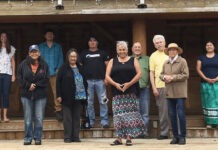
Maori, who account for about 15% of the population, were dispossessed of much of their land during colonization by Britain
By Charlotte Greenfield and Praveen Menon
AUCKLAND/WELLINGTON (Reuters) – Five years ago, law graduate Pania Newton and her cousins got together around a kitchen table and agreed to do everything in their power to prevent a housing development on a south Auckland site considered sacred by local Māori.
Newton, now 29, is today leading thousands of protesters occupying the land at Ihumātao, one of a number of grassroots movements spearheaded by young, educated and tech-savvy Māori women.
Using social media and crowd-funding websites, the groups are mobilizing community support to demand land rights and other reforms for Māori in the highest-profile indigenous rights campaigns in more than a decade.
“When you look at our campaign you’ll see the majority of us involved are women and that’s because we feel this great sense of connection to Mother Earth,” Newton told Reuters.
“We are the nurturers, we are the carers. We’ve had to overcome many, many challenges for thousands of years and we’re strong, we’re resilient, we’re feisty and we’re fierce.”
In another demonstration, thousands marched in the capital Wellington last week protesting the removal of at-risk Māori children from their families.
FACTBOX-History of recent protests by Māori in New Zealand
The issues have become proxies for a wider discontent among young Māori about modern New Zealand, and disenchantment with the government which some say has done little to break cycles of poverty and violence.
Māori, who account for about 15% of New Zealand’s population, were dispossessed of much of their land during colonization by Britain in the 19th century.
A legal settlement process drawing on the nation’s founding document, the 1840 Treaty of Waitangi, has restored some rights and assets, but many Māori say those measures have not gone far enough.
Without their ancestral lands, with which people are spiritually connected to in the Māori world, and with the erosion of many cultural rights until the late 20th century, Māori families are disproportionately affected by a raft of social problems from imprisonment to homelessness.
NEW WAVE
While eating a hot lunch of bacon bone stew, Iru Iti, a Māori language orator with ancestral ties to Ihumātao and related to Newton, waited out the pouring winter rain beneath a large tarpaulin covering a makeshift meeting ground at the protest site.
The 53-year-old said his nieces’ leadership and knowledge of how to navigate both the Māori and Western worlds was revitalizing his people’s fight for social justice.
“Until very recently I never believed we could do what we did. If my father were still alive he’d think this is amazing,” said Iti, sitting on a plastic chair between the protesters’ campsite and a line of police.
Māori have a long history of activism to fight for their rights and culture. The protests at Ihumātao echo a 1977-78 occupation of Auckland’s Bastion Point by a local tribe, which ended after 507 days when police forcibly removed and arrested hundreds of protesters.
But many notice a difference in the new wave of protest that has emerged, which is also challenging some traditional leaders and spokespeople.
The protesters occupying Ihumātao do so in disagreement with a tribal authority with links to the area, which has supported the housing project after gaining a number of concessions from the developer, including moving the planned housing back from the main protected heritage area.
“I think to a large extent it’s people traditionally shut out of power who are beginning to assert themselves more powerfully in public,” said Morgan Godfery, a Māori political commentator.
Many of those behind the protests against the removal of Māori children from their homes are young mothers, grandparents, midwives and adults who suffered abuse in state care as children.
They have formed a network called ‘Hands Off Our Tamariki’, using the Māori word for ‘children’.
Laura O’Connell Rapira, 30, the director of campaign organization ActionStation, helped organize the recent Wellington march and uses social media and crowd-funding to build support the “Tamariki” campaign as well as the protesters at Ihumātao.
“Māori communities have always organized collectively…but digital tools have made it a lot easier for us to do that from different areas and at a speed and scale like never before,” she said.
Prime Minister Jacinda Ardern’s centre-left government refused to intervene in the Ihumātao stand-off at first and she has not visited the site but, as the protests grew, she announced there would be no building on the land until the dispute was resolved.
On the removal of children, Ardern has said she did not watch a documentary by online new site Newsroom showing state officials trying to take away a new-born baby from his Māori mother, which sparked the protests.
“There is a kind of wilful refusal to look at the messy and hard and difficult stuff and the anguish that these actions are creating in Māori communities,” said Joanna Kidman, Associate Professor of indigenous sociology at Victoria University of Wellington.
Ardern did not respond to a request for comment on this story. Her office has previously said too many children were ending in state care and too many were being killed or hurt by their families – both long-term problems the government is trying to fix.
‘METRICS AND MESSAGING’
At Ihumātao, a volunteer social media team overseen by Qiane Matata-Sipu, one of Pania’s cousins whose kitchen table was where the movement was founded, hunch over laptops powered by a generator and connected to the internet via portable 4G devices.
The volunteers discuss fine-tuning “messaging”, the need to do a livestream before 5 pm to ensure the highest number of views, and parsing metrics of online engagements, which numbered half a million on Facebook in the first nine days.
“The messages we are able to share on social media have power…we’re connecting globally,” said Matata-Sipu.
Down in the kitchens, 16-year-old Torere, who only gave her first name, has been posting Instagram stories in between helping prepare food or while keeping vigil at the frontline facing police.
“Social media’s working – they’re listening, they’re coming,” she said, watching her posts get screen-shotted and shared, which sometimes led to her friends turning up in person.
The messaging has gone far afield. Groups as diverse as indigenous Taiwanese, Muslim and immigrant communities, unions and musicians have travelled to Ihumātao, while smaller protests have also taken place around the country.
Meanwhile, some of the traditional landowners of Tumu Kaituna, in the North Island’s Bay of Plenty region, are working to ensure their land cannot be sold.
As they wait for the result of a court appeal, a 30-strong committee made up mostly of women, is setting up an online petition and preparing logistics to occupy the site.
“Ihumātao has been an inspiration for Tumu Kaituna,” said Renee Kiriona, a member of the group. “Now there’s some hope.”
(Reporting by Praveen Menon and Charlotte Greenfield. Editing by Lincoln Feast.)






